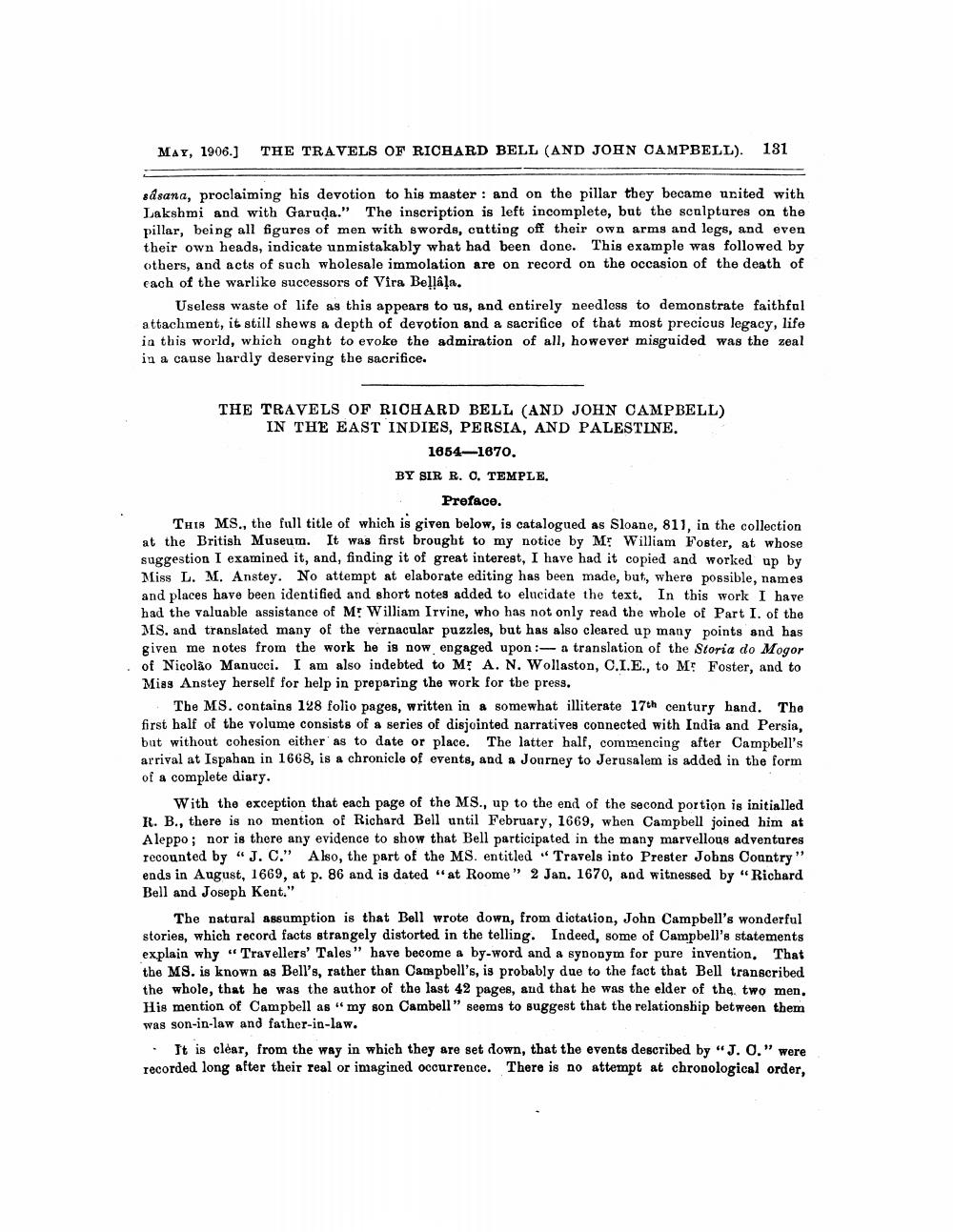________________
MAY, 1906.]
THE TRAVELS OF RICHARD BELL (AND JOHN CAMPBELL). 131
sdsana, proclaiming his devotion to his master : and on the pillar they became united with Lakshmi and with Garuda." The inscription is left incomplete, but the sculptures on the pillar, being all figures of men with swords, cutting off their own arms and legs, and even their own heads, indicate unmistakably what had been done. This example was followed by others, and acts of such wholesale immolation are on record on the occasion of the death of each of the warlike successors of Vira Bellaļa.
Useless waste of life as this appears to us, and entirely needless to demonstrate faithful attachment, it still shews a depth of devotion and a sacrifice of that most precicus legacy, life in this world, which ought to evoke the admiration of all, however misguided was the zeal in a cause hardly deserving the sacrifice.
THE TRAVELS OF RICHARD BELL (AND JOHN CAMPBELL) IN THE EAST INDIES, PERSIA, AND PALESTINE.
1854-1870. BY SIR R. O. TEMPLE.
Preface. This MS., the full title of which is given below, is catalogued as Sloane, 811, in the collection at the British Museum. It was first brought to my notice by Mr William Foster, at whose suggestion I examined it, and, finding it of great interest, I have had it copied and worked up by Miss L. M. Anstey. No attempt at elaborate editing has been made, but, where possible, names and places have been identified and short notes added to elucidate the text. In this work I have had the valuable assistance of M: William Irvine, who has not only read the whole of Part I. of the MS, and translated many of the vernacular puzzles, but has also cleared up many points and has given me notes from the work he is now engaged upon :- a translation of the Storia do Mogor of Nicolão Manucci. I am also indebted to M: A. N. Wollaston, C.I.E., to M! Foster, and to Miss Anstey herself for help in preparing the work for the press.
The MS. contains 128 folio pages, written in a somewhat illiterate 17th century hand. The first half of the volume consists of a series of disjointed narratives connected with India and Persia, but without cohesion either as to date or place. The latter half, commencing after Campbell's arrival at Ispahan in 1668, is a chronicle of events, and a Journey to Jerusalem is added in the form of a complete diary.
With the exception that each page of the MS., up to the end of the second portion is initialled R. B., there is no mention of Richard Bell until February, 1669, when Campbell joined him at Aleppo; nor is there any evidence to show that Bell participated in the many marvellous adventures recounted by "J. C." Also, the part of the MS. entitled “Travels into Prester Jobns Country" ends in August, 1669, at p. 86 and is dated "at Roome" 2 Jan. 1670, and witnessed by "Richard Bell and Joseph Kent."
The natural assumption is that Bell wrote down, from dictation, John Campbell's wonderful stories, which record facts strangely distorted in the telling. Indeed, some of Campbell's statements explain why “Travellers' Tales" have become a by-word and a synonym for pure invention. That the MS. is known as Bell's, rather than Campbell's, is probably due to the fact that Bell transcribed the whole, that he was the author of the last 42 pages, and that he was the elder of the two men, His mention of Campbell as "my son Cambell" seems to suggest that the relationship between them was son-in-law and father-in-law.
• It is clear, from the way in which they are set down, that the events described by "J. 0." were recorded long after their real or imagined occurrence. There is no attempt at chronological order,




